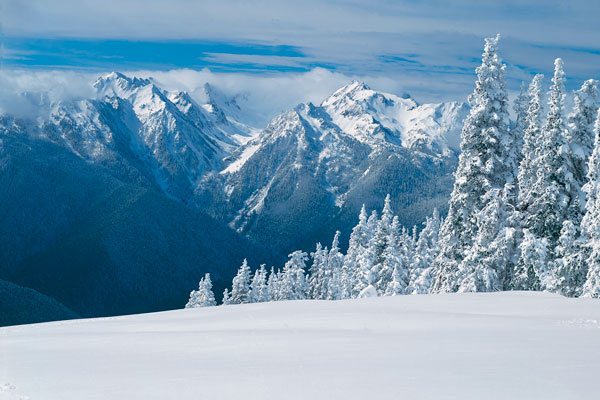Fresh snowfall leaves the ground smooth and white. Boots crunch on the fresh snow and crisp, frosted air stings the lungs. The earth is still, save for a lonely crow call and the branches rattling in the wind. Winter has settled on the Dungeness Valley.
The season brings dramatic changes to the landscape, from snowfall on mountain peaks, to the leafless skeletons of alder trees to icy swirls in puddles. This season of stillness has an especially profound effect on the artists who memorialize it in their work.
A few Sequim artists weighed in on how the winter season affects them, including photographer Ross Hamilton, who sees it on a technical level, and painter Lynne Armstrong, who feels more of an emotional connection with the season.
Winter’s environmental effects are most pronounced for visual artists like Hamilton, who said the stillness of the winter air provides a clarity that the summer can’t rival.
“We were out on Marrowstone Island and Mount Baker just loomed up in front of us and it was gorgeous because it was such incredibly clear air,” Hamilton said.
By comparison, Hamilton said, the warm summer air creates too much haze.
“Mount Baker here at sunrise is gorgeous, but as soon as the sun gets high enough to be seen, the mountain disappears,” he said.
Hamilton said winter is a “still” time due to the absence of convection currents that cause summer breezes. Fewer winds and freezing temperatures make bodies of water calm as mirrors and trees stand still against the backdrop of the clear mountains. The season’s stillness is a major theme in the work of many artists as they capture the world at a quiet and withdrawn time.
Armstrong defines the season as quiet, spacious and still, but thinks that it also has a “hidden” quality. Fog or snow obscures the landscape and hides trees, covering lingering signs of seasons past.
“The image that I really love is an old apple tree with just a few apples left on it,” she said, which to her suggests a memory of the summer and fall.
When features are not hidden, Armstrong said, barren winter landscapes also are beautiful for their exposed qualities.
“You have the skeleton of the land, the bone structure,” she said.
The starkness and simplicity of winter landscapes have a profound effect on the mood of many visual artists, such as photographer Pam Walker.
In the darkness and moodiness of winter, artists document different subjects and create different images than in the summer.
Walker said she finds herself switching from macro images, close-up shots of small subjects, in the summer to landscapes in the winter. She said her work becomes less colorful and more black and white with solitary objects. Buildings and trees are featured prominently.
“I’m definitely driven by moods,” she said. “I think a lot of artists probably are. If I’m happy, I’ll take pictures of flowers or something bright and cheerful, and if not, it gets more moody and much more lonely.”
Walker said that it’s not a sad kind of lonely, but more solitary and reflective, similar to Armstrong’s idea of winter as a time for introspection.
It’s a reflective time that allows her to consider her previous year’s work and think about the future of her art, Armstrong said.
“It’s a contemplative time for me,” she said. “It’s a really good time to revisit those questions and say, ‘What is it that I’m asking people to look at?’”
As a season, winter is seen as a period of hibernation, where the snow, fog, frost and rain keep people indoors with the heat on. But for those willing to venture out of the comfort of their dens, the season provides hundreds of artistic opportunities, whether it’s a single mountain tree obscured by fog or the reflections of mountains over Lake Crescent.
At the same time, it gives the painters, sketchers and photographers in everyone a chance to slow down, reflect, focus and explore the beauty of nature.



